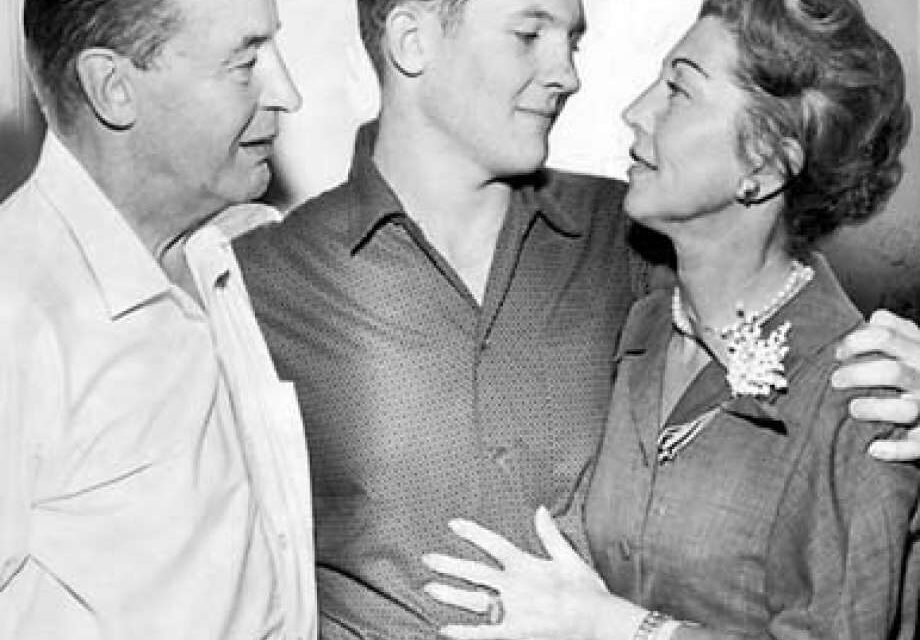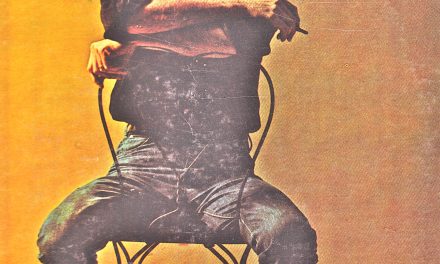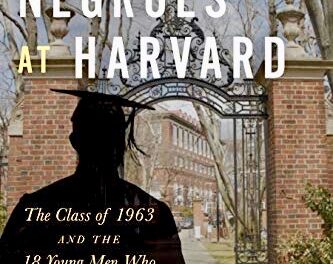Terence Tyrone “Kayo” Hallinan entered the ring in 1937, the second of five boys born two years apart, as per mother Vivian’s plan, and given nicknames by father Vincent, who would train them to be roughnecks. Before Kayo came Patrick (“Butch”) and after him came Michael (“Tuffy “), Matthew (“Dynamite”) and Conn (“Flash” at first, “Ringo” after he saw John Wayne in Stage Coach at age seven.)
Vivian would have two miscarriages, both boys. In 1951 she had another boy, Daniel, whose nickname (“Dangerous”) didn’t stick. Vince taught them all how to box and arranged for pro fighters to provide advanced tutelage. The four oldest all would win university boxing titles. Kayo tried out for the 1960 US Olympic team and fought an exhibition bout with Cassius Clay, who the world remembers as Muhammad Ali. “I saw Kayo box against Stanford when he was at Cal,” brother Ringo recalls. “He hit this Stanford guy so hard with a right that he knocked him through the ropes and into the front seats.” (More from Ringo next week on the Hallinan’s proclivity for brawling.)
Vivian and Vincent Hallinan achieved tremendous professional success in the 1940s, she in San Francisco real estate, he in Superior Court (both the civil and criminal sides). When the wartime occupancy rate for apartments was only 65% during World War Two, Vivian had tenants in 93% of hers. She was a hands-on general manager and wrote a handbook for her superintendents and janitors. By 1948 her real estate company owned and managed 435 rental units in the city. All were on Nob Hill or below, except one on Geary Street. Kayo once told me with admiration, “After the war she bought big tracts of land in Marin County for $50 an acre.” When I met him in 1968 he was living in a pleasant flat on Green Street in a building owned by the family —as was his office on Franklin Street.
Vincent won record-breaking settlements in damage suits —$125,000 from Bank of America, $195,000 from Bechtel. “Both were stunning awards,” according to his biographer, Joseph Walsh, “which initiated a new era in American legal history.” In a case that made front-page headlines for months in 1945, he achieved a miraculous manslaughter verdict for Irene Mansfeldt, who had shot and killed a woman she assumed her husband was getting it on with. Irene had confessed to eight people at the scene of the crime (outside the old Central Emergency Hospital on Golden Gate Avenue), and handed over the revolver that did the deed. Then she confessed to the police.
Irene Mansfeldt’s husband John was a wealthy physician who Vincent had protected from bullies back at St. Ignatius starting in 1913. (Small town!) Dr. Mansfeldt didn’t make friends easily, and he asked Vincent to be his best man when he married Irene in 1925. (Irene had cried inordinately, Hallinan would recall.) Dr. Mansfeldt had delivered the first five Hallinan boys. After Irene shot his supposed mistress, he committed suicide. Irene was charged with first-degree murder by San Francisco’s new district attorney, Edmund G. Brown, Sr., and was facing the death penalty when she hired Vincent Hallinan
He began by trying the case in the press (the city then had four dailies), giving extensive interviews to female reporters. After the prosecution’s succinct opening statement, Hallinan enthralled the jury for three hours. On the night before the shooting, he said, Dr. Mansfeldt had given Irene strong sedatives which produced “a sleep so abnormal it tore loose the structure of her subconscious mind… When she awakened in the morning, she was suffering from a condition recognized both by law and medicine —the condition known as somnolentia, in which she gave the aspects of consciousness but actually was only semi-conscious. In this state, her subconscious mind controlled her personality.” Nowadays it would be called The Ambien Defense.
Hallinan brought in the three Mansfeldt children to testify that on the morning of the killing their father had to throw water on her to wake her up, and then she kept stumbling. Hallinan deployed an expert witness from Stanford Medical School to confirm the somnolentia diagnosis. His cross-examining of the prosecution expert, a UCSF neurologist, featured a large map of the brain (an organ the doctor had mentioned when testifying). Hallinan asked him to identify and locate various obscure substructures: “What division is there of the anterior portion of the fissure of Sylvius? Do you know what they are called?… Do you know what the portion of the frontal lobe under the anterior horizontal ramus is called?” The relentless barrage continued and the witness kept protesting that he was not a neurosurgeon or a neuro-anatomist. Hallinan said, “Well, if a man gets up here and claims to be an automobile expert and he doesn’t know a carburetor from a filling stem, some doubts might be cast on his qualificatons.
In the midst of the Mansfeldt murder trial, Patrick and Michael Hallinan were hospitalized with polio and Vivian started to miscarry. Patrick had the more virulent strain, and his life hung in the balance for five days. He would spend six months in an iron lung. Their father read everything he could about polio —he always did thorough research as a lawyer— and attributed Patrick’s survival and Michael’s recovery to their underlying health and strength. Soon the Hallinans bought an estate in Ross, a classy town in Marin, the county whose residents had the highest per capita income in California. Vivian restored the 20-room Mediterranean-style villa and Vince oversaw installation of a football field, an Olympic-sized swimming pool, a full-court gym, and a boxing ring.
Summers were spent at Camp Mather near Yosemite, where the Hallinan’s did a lot of horseback riding. In late August 1948 Kayo and Patrick set out on horseback for Benson Lake, a site deep in the wilderness, accompanied by two cowboys and a professional guide. It was real wilderness, not yet logged. They had almost arrived at their destination when 11-year-old Kayo was thrown from his horse and suffered a fractured skull. The cowboys rode back and notified Vincent and Vivian, who then rode in with a doctor and found their son unconscious and cold to the touch. The doctor said he could recover if hospitalized soon, but might not survive being carried back in a litter, which would take five days. The newspapers picked up on the story and it became front-page news. As a result of the publicity, a helicopter manufacturer assigned an ace test pilot to attempt a rescue. (At the time the helicopter was generally thought to be something out of science fiction.) The mission succeeded and our young protagonist lived to enter seventh grade.
In the decade ahead, the US would move to the right, politically, and the Hallinans would move to the left. The turning point came in 1950, when Vincent defended Harry Bridges, the leader of the International Longshoremen and Warehousemen’s Union, against a federal government intent on deporting him to his native Australia. Bridges had previously been investigated and accused by the Immigration Service of membership in the Communist Party (CP), which Congress had defined as a subversive organization by the Smith Act of 1940. He had been acquitted by a 5-4 decision of the US Supreme Court in 1945. Then in 1950 Bridges and two other ILWU leaders were accused of conspiracy to defraud the US government by falsely denying membership in the CP —a slight variant of the charges he had narrowly beaten in ’45.
Harry Bridges’ mother came from a family of Irish nationalists recently settled in Australia, and he was radicalized by uncles who were Labor Party activists. He shipped out at 16 and became a San Francisco longshoreman in 1922. In 1934, when a strike by the International Longshoreman’s Association shut down the piers, Bridges was a rank-and-file leader. The strike was broken by SFPD officers trucking goods unloaded by scabs through the ILA picket lines, and assaulting a union hall, killing two workers. The famous general strike of San Francisco workers followed; it lasted four days. Eventually, over Bridges’ objections, the ILA leaders went back to work on the terms the Waterfront Employers’ Association were offering. Bridges’ popularity among the rank-and-file kept growing and he became president of the ILA’s SF local in 1935. In ’37 his faction seceded from the ILA and formed the ILWU, which soon won the allegiance of workers at almost all the West Coast ports and the enmity of the shipping companies.
Although Hallinan had played a minor role in 1934, bailing out longshoremen on the union’s behalf, he didn’t know Bridges. He would tell his biographer: “When Harry Bridges looked me up, I had never defended in a political trial and I was terribly naive. In the Bridges case I learned more about justice and its perversion that I had in 30 years of prior practice and 30 years since.” All that he learned was shared in detail with his wife and children.
To be continued
Vincent Hallinan had believed Harry Bridges when he said that he had never joined the Communist Party (CP). This meant there could be no documentary evidence to the contrary produced at the trial —no authentic membership card or signed application, no dues receipt, no booklet in which party members posted little stamps that showed their dues were paid up. Bridges said he respected and openly associated with CP members, that CP members in the ILWU made proposals that the rank-and-file often supported, but he himself had never joined. Hallinan decided to flip the accusation by showing that federal officials had conspired with the shipping magnates to frame the militant union leader, and that all the witnesses against Bridges were paid informers schooled by the prosecution on what to testify.
The US government’s third attempt to deport Bridges as a Communist was tried by US District Judge George B. Harris, who had graduated from the law school at St. Ignatius (now USF) in 1925, five years after Vincent Hallinan. The trial began in April, 1950, and would go on for seven acrimonious months. Hallinan’s repeated assertion that the US government was trying to frame Bridges was seen by Judge Harris as an affront to his court. The judge’s animosity became increasingly evident and Bridges, the strong-willed leader of the dockworkers, urged a less confrontational defense. He wanted Hallinan to rely on the absence of documentary evidence linking him to the Communist Party —the strategy that had brought vindication by a 5-4 vote of the Supreme Court in 1945. But his strong-willed lawyer would not relent, and kept accusing the prosecution of conducting a chorus of false witnesses. He was building up a record for appeal.
 Had he changed his approach, Hallinan told his biographer, Joseph Walsh, “Bridges would have a nice, neat, quiet and short trial. They would say he was a Communist. We would say he wasn’t. Harry would be found guilty and would have a far less meritorious appeal record. He deserved better than that from me and I gave it to him even though it took him a little while to realize it.”
Had he changed his approach, Hallinan told his biographer, Joseph Walsh, “Bridges would have a nice, neat, quiet and short trial. They would say he was a Communist. We would say he wasn’t. Harry would be found guilty and would have a far less meritorious appeal record. He deserved better than that from me and I gave it to him even though it took him a little while to realize it.”
One day in August Judge Harris stunned all in attendance by denouncing Hallinan’s conduct and citing him for contempt. He ordered Hallinan to be imprisoned and disbarred. The prosecutor called for Hallinan to be hauled off immediately and replaced by his able co-cousel, James Martin MacInnes. The defendant nixed the plan. Without Hallinan, Bridges said, “If things go wrong, I’ll never, never think it was a square deal.” The judge, fearing a mistrial, ordered that Hallinan’s six-month sentence be served after the trial. In the spring and summer of 1952, Vincent Hallinan would do his time at McNeil Island, a federal prison in Puget Sound. He had a good job tending the chicken coop and called prison “an interesting experience.”
Harry Bridges was found guilty by Judge Harris. In 1953 the US Supreme Court reversed the conviction on statute-of-limitation grounds. Using the Wartime Suspension Act to deport Bridges, they ruled, violated its purpose. The Immigration Service then sued the ILWU in civil court, citing some of the previously used informers. Federal Judge Irving Goodman dismissed the suit with an oblique shot at Judge George B. Harris: “Only a weak yielding to extra-judicial clamor would excuse acceptance of the testimony of the witnesses… as proof of the allegation of the conspiracy.”
The US government continued trying to make life miserable for Bridges. The IRS taxed the funds raised for his legal defense —hundreds of thousands of dollars— as personal income. McCarthyism was on the land.





